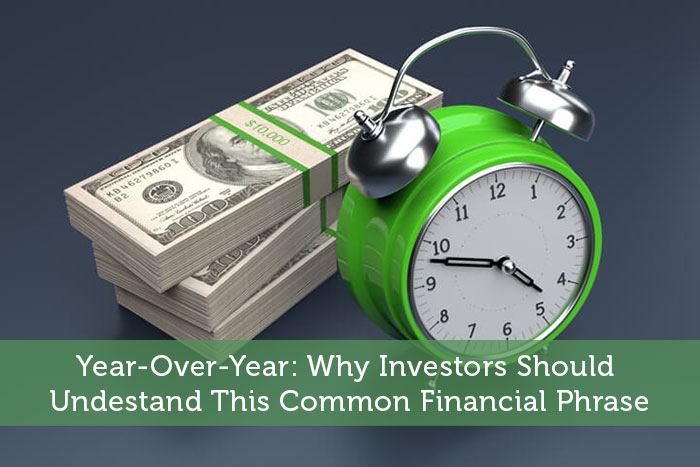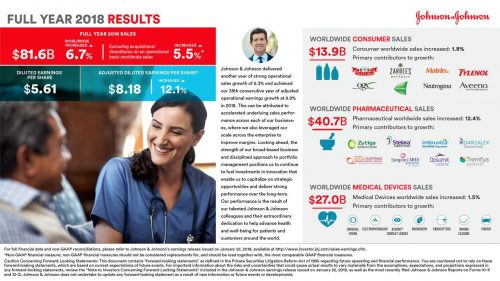Investors and business leaders tend to use the phrase “year-over-year” on a frequent basis when discussing a company’s results. Year-over-year is often abbreviated as YoY.
The concept of YoY is simple: to compare the results from one reporting period to the results of another as a way to measure improvement or deterioration in a company’s results. This can be done with years, half years, quarters, or any other time frame. However, YoY is certainly the most common and, in our view, the most useful.
For example, if a company earned $2 per share in 2017 and then earned $3 per share in 2018, the company would have experienced YoY growth of 50%.
This article will discuss further YoY growth, how it is used, and why it matters to investors.
Year-Over-Year In Practice
Companies in the US generally report their financial results in three month increments and at the end of the fiscal year, which may or may not coincide with the calendar year, it will report full-year results in addition to its quarterly results. Reports are made available in the three basic financial statements: income statement, balance sheet, and statement of cash flow. Some companies will also provide a statement of comprehensive income, which shows other items impacting profitability that don’t belong on the income statement. Regardless, these items are provided at quarterly and annual intervals.
Given that this reporting structure is in place, investors naturally want to know if a company’s prospects are improving or deteriorating, and the best way to do that is to analyze one period’s results against the prior period’s results. This can be done on a quarterly basis and an annual basis at the end of the year. It can also be done with any metric from any of the financial statements that is of interest to investors.
The way one would do this is to take a financial metric from one period and compare it to the same metric in the same length of period at some point in the past. Essentially, this just means the investor would take revenue, as an example, for 2018, and compare it to revenue for 2017. The change in revenue in 2018 divided by revenue in 2017 gives the investor the YoY growth (or decline) in the company’s revenue.
Recommended Stock Investing Posts:
- Top 3 Bollinger Bands Trading Strategies
- Critical Reasons To Invest In Small Cap Stocks
- Using The Power Of The 80-20 Rule For Larger Returns
- A Review of The Truth About Money by Ric Edelman
- Traditional IRA vs. Roth IRA vs. 401k
- The Neatest Little Guide to Stock Market Investing Book Review
- 6 of the Most Popular Instruments for Financial Traders
- Investment Diversification: 5 Risky Mistakes to Avoid
For example, Johnson & Johnson (JNJ) reported full-year revenue of $81.581 billion in 2018 against full-year 2017 revenue of $76.450 billion. The change in revenue, therefore, for 2018 was $5.131 billion, or 6.7%. In this example, using Johnson & Johnson’s revenue for 2018, YoY growth came in at 6.7%.
Johnson & Johnson also reported that adjusted earnings-per-share rose 12.1% in 2018, which is nearly double the rate of revenue growth. Just knowing these two numbers would let investors know that the company is growing earnings-per-share much more quickly than revenue. This is a good thing, and the investor would know to dig into the results to discover why. Is it share repurchases? Is it lower cost of goods sold? Is it lower back office costs? The answers to these questions help investors understand if they’d want to own Johnson & Johnson shares, and it all starts with YoY analysis.
This can be done for any metric on the income statement, balance sheet, or statement of cash flow. Revenue and earnings are the two most generally used metrics when comparing a company’s results YoY, and the calculations are easy to perform. In addition, many companies, Johnson & Johnson included, will perform these calculations for investors and present them in their financial statements, making YoY analysis of results even easier.
When a company is reporting a period that isn’t a full year, YoY comparisons are still quite valuable. For instance, if a company is reporting first quarter earnings, it is common for investors to compare the results of this year’s Q1 to the results of last year’s Q1. This gives investors a look at a much smaller reporting period, but one that is still quite valuable.
The concept of YoY comparisons affords investors the ability to directly compare similar periods over different years to then gauge whether or not the business is improving. If, for example, a company’s revenue is lower in this year’s Q1 than in last year’s Q1, the investor would want to dig into the results to understand why.
Did a one-time item impact this year’s results or last year’s? Did the company lose a major customer? Was this year’s Q1 shorter in terms of operating days than last year’s? Was there a natural disaster that could have impacted results? These are all valid questions to ask when a company’s results deteriorate, but the starting point is the same. The investor must do some YoY analysis to determine if there is a problem in the first place, before being able to understand where the problem came from. Having this information allows the investor to determine if the problem is short-term and will pass, or is more permanent and concerning.
Final Thoughts
While there are certainly many ways to analyze a business’ performance, we think a good starting point is to do some basic YoY analysis. This provides context for a company’s performance against a similar period in a different year, and also affords the investor the ability to know which questions to ask. This allows investors to more deeply understand how a business is performing and whether or not to invest in that business.
However, that isn’t the only type of analysis that can be done on a company. Qualitative analysis, such as the competitive landscape, new products that may be coming into play in the future, mergers and acquisitions, etc., also help make the case for or against a particular stock.
In addition, we see dividend analysis as very important when choosing stocks to hold for the long-term. A great place to start is the Dividend Aristocrats, which is a group of
S&P 500 stocks with at least 25 consecutive years of dividend increases. This group of elite dividend stocks consists of many of the best dividend stocks available to investors today.
Analyzing results year-over-year is a great way to help determine which stocks are the best for potential investment.





